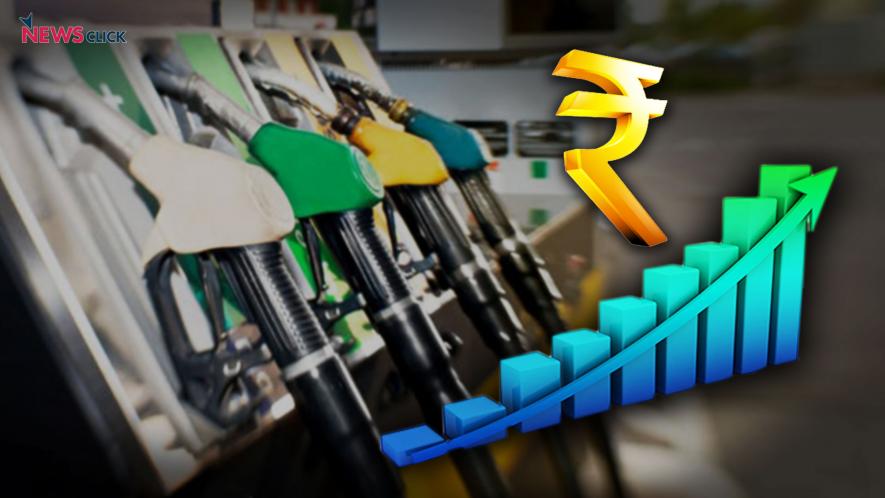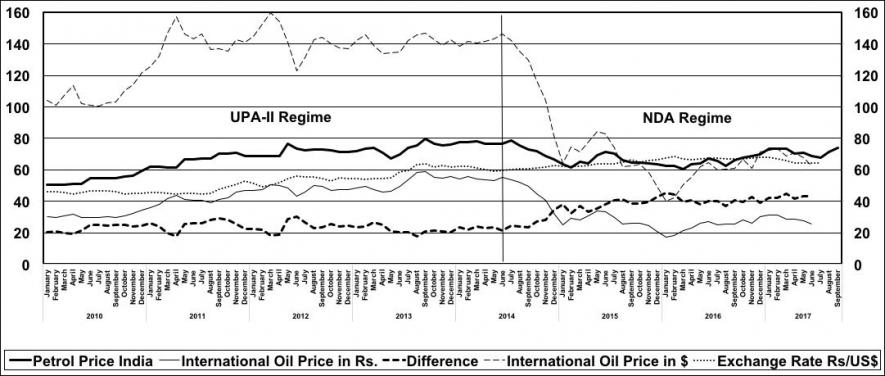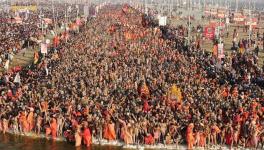Oil Price Hike in the Time of BJP

Newsclick Image by Nitesh Kumar
The country is suffering again as the average price of petrol has reached Rs.75 per liter and the average diesel price has reached Rs.62 per liter by the mid-September. The retail price of petrol was this high during the second half of 2013 and the first half of 2014 i.e. during the last year of the UPA-II government. The average international price of crude oil was more than 140 US dollar per barrel (1Barrel=159 liters approx.) then. The NDA government was formed in end of May, 2014. Fortunately, the international crude oil price came down from 146.5 US dollar per barrel (in June 2014) to only 62 US dollar per barrel by January 2015. However, as compared to a drop of 55% in the international price of crude oil, the domestic retail price of petrol registered a drop of merely 22% during the same time period. Thus, less than 50% of the benefit of reduction in the international price of oil was passed on to the domestic consumers in India. The international price of crude remained less than 70 dollar per barrel since then. The difference between domestic and international price of oil has gone up substantially during the time of NDA government as compared to that during the UPA-II time. The petrol price went up to near Rs.80 per liter during the UPA time primarily because of the high international price of crude oil. But, the recent increase to Rs.75 (more than Rs.80 in Mumbai and elsewhere) per liter has not happened due to any increase in the international oil price but because of the increase in the difference between the domestic selling price and international price of oil. This gap comprises of the cost of refining, marketing (including the profit of the oil marketing companies) and the taxes. There is no evidence to suggest that anything other than tax components of the difference under consideration have gone up significantly during last 3 years. As a proportion of GDP, the sales tax revenue from the petro-products, which accrues to the state governments, has also not gone up. However, the central government’s tax revenue from petroleum products has almost doubled as the proportion of GDP during the last two years from 0.9% to 1.8% of GDP (See Bose, P dated 14th September, 2017). Therefore, this time, the price hike has happened primarily because of the higher tax collection from the petro-products by the central government. This has been the main story of oil price in the time of BJP. The argument can be substantiated with the help of the following empirical evidence.
Graph: Price of Petrol in India and International Oil Price in US$ & in Rupees

Source: Indian Oil Corporation Limited (IOCL), Reserve Bank of India (RBI) and International Monetary Fund (IMF).
In the above chart, monthly data from January, 2010 to September, 2017 has been considered on three variables viz. average international price of crude oil (simple average of the Dated Brent, West Texas Intermediate and the Dubai Fateh) in terms of US dollar per barrel from primary commodity price database of IMF, the exchange rate of rupee per US dollar from the handbook of statistics, RBI and the domestic average price of petrol in rupees per liter (for the four metro cities of Delhi, Kolkata, Mumbai and Chennai) from the Indian Oil Corporation Limited (IOCL). The entire period has been divided into two parts – the UPA-II regime (i.e. upto May, 2014) and the NDA regime (June 2014 onwards). The top most broken line depicts the movement in the international average price of crude oil in terms of US dollar per barrel. This went up to 160 US dollar in 2011 and 2012 from 100 dollars per barrel in mid-2010. This was around 140 dollars per barrel till June 2014. Then, as mentioned above, the sharp decline takes place and it stabilizes below 70 dollars per barrel. The dotted line draws the movement in the exchange rate of rupee per dollar, which has gone up from around Rs.45 per dollar to Rs.65 per dollar on an average during the time period under consideration. With the help of this exchange rate, we have converted the international crude oil price series in dollar per barrel into rupee per liter series, which is depicted by the unbroken thin line in the above graph. Clearly, it went up from around Rs.30 per liter in the beginning of 2010 to Rs. 59 (almost double) by September 2013. In June 2014, it was more than Rs.55 when the current BJP government assumed office. However, luckily it came down to Rs.25 per liter by January, 2015. It has stabilized more or less near Rs.30 per liter now. When the international crude price went up from Rs.30 to Rs.60, the domestic petrol price also went up from Rs.45 to almost Rs.80. However, when the international price came down from Rs.55 to Rs.25, the domestic price of petrol came down from Rs.78 only to Rs.62 per liter. Therefore, the domestic consumers were deprived of getting the benefit of the lower international oil prices. The unbroken thick line depicts the retail price of petrol (average of Delhi, Kolkata, Mumbai & Chennai) in the graph above. It never went down below Rs.60 per liter before firming up again to more than Rs.74 per liter.
What distinguishes the NDA regime from the UPA-II regime, vis-à-vis the oil price policy, is the thick broken line measuring the difference between the domestic petrol price and the international price of crude oil in terms of rupees per liter. As is clearly evident, this difference has been maintained at a very high level of Rs.40 per liter since January, 2015. The thick broken line depicts how the gap increased from around Rs.23 per liter during the UPA regime to as high as Rs.40 per liter in the NDA regime. As mentioned above, this has happened primarily because of larger tax collection from the petroleum by the central government. Therefore, the recent hike has not happened out of compulsion but it was a deliberate government policy to raise the price.
The union minister for tourism of the present NDA government, Shri K J Alphons has clarified this on record, “it is an intentional decision made by the government. We are going to tax people who can afford to pay. … … We are here for welfare of the downtrodden, ensure electricity in every village, make houses, build toilets. It is going to cost enormous amount of money” (See Scroll.in dated 16th September). Many serious studies, however, have shown that the rise in oil price has a significant negative impact on growth and inflation in the Indian context (See Das, Bhanumurthy & Bose, Springer, 2014). Nobody is against larger pro-poor social sector expenditure, however, pitting one against the other is a cliché tactics. The direct taxes, and not the indirect taxes, are levied following the ability to pay approach. If the government would have been really serious about collecting more taxes, from those who can pay, in order to incur larger pro-people expenditures, the revenue from various direct taxes like income and profit tax should have been increased for those who have the ability to pay. However, when the international price is more or less stable, if the domestic price of petro-products increases to a very high-level due to higher taxation, it is not justifiable. It is definitely going to increase prices in every other sector of the economy and reduce growth on the face of the current slowdown. Instead of providing petroleum subsidy, if the petroleum sector is used as the main vehicle to raise more indirect tax revenue in the central exchequer, it would go against the interest of the majority of the common people of this country. The direction of the pro-people policy should be to reduce petroleum price in the country by reducing the central government taxes on petro-products and to expand expenditure by raising more direct tax revenues from the rich profit and income earners.
Get the latest reports & analysis with people's perspective on Protests, movements & deep analytical videos, discussions of the current affairs in your Telegram app. Subscribe to NewsClick's Telegram channel & get Real-Time updates on stories, as they get published on our website.
























